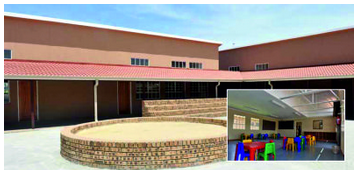Infrastructure development
Last year Thato Kekana attended school in a prefabricated classroom, always at the mercy of the weather.
 Those days are over for the 11-yearold, who will complete her final year of primary school in the comfort of South Africa’s first environmentally friendly school - Orefile Primary.
Those days are over for the 11-yearold, who will complete her final year of primary school in the comfort of South Africa’s first environmentally friendly school - Orefile Primary.
The school in Olievenhoutbosch, Gauteng has been dubbed the “Green School” and opened its doors for the first time in 2013.
Kekana used to share a prefabricated classroom with 48 pupils at Philena Primary School.
She recalled the problems she experienced at her previous school. “During winter the classroom got really cold and in summer it would get extremely hot. The school had a lot of dust and it caused me to sneeze all the time.”
Kekana is excited about her new school where she will be able to take part in sports such as netball and volleyball.
Of the 1 192 pupils at the Kekana’s old school, 617 have been transferred to Orefile Primary, while the rest will remain at Philena Primary. Orefile Primary was built using alternative construction methods, which are environmentally friendly.
“This building system comprises lightweight steel frames that are joined together and cladded with fibre cement boards filled with lightweight concrete mix. The assembling and fabrication of the steel superstructure was done on site using trained labour,” said Chief Operations Officer of the Industrial Development Trust (IDT) Ayanda Wakaba.
The Gauteng Department of Infrastructure Development instructed the IDT to build Orefile Primary and it took just 10 months to complete the school, which is worth R33.4 million.
“The system used was easier and faster when constructing, cutting down on time and costs compared to the conventional brick and mortar methods. No stone or wood was used and all material was manufactured on site reducing the transport carbon footprint,” explained Wakaba.
The system is compliant with international building standards and meets the testing requirements of the South African Bureau of Standards and Agrément South Africa.
Using alternative construction methods means that the building can resist fire for up to four hours, the walls are three times lighter than brick walls and was easily erected and rapidly constructed.
“The building is scuff and abrasion resistant. It has a thermal insulation meaning that it can store heat during winter. It has sound insulation and even though the walls are lighter, they do not transmit sound easily. This means that one can’t hear the sound coming from the next classroom,” Wakaba added.
The school has 24 classrooms - three for Grade R, eight for the foundation phase, nine for the intermediate and four for senior phase.
It also has an administration block, computer and multimedia rooms, storerooms, laboratories, sport fields, ablution facilities and a nutrition centre.
During a tour of the school, Clever Shikwambane, the first principal of Orefile Primary, said his initial concern was keeping the school in its current condition.
At Orefile Primary green grass covers the combined rugby and soccer field, with the netball and tennis court nearby.
Green fencing encircles the school and the fields surrounding it. There are large quad areas that will be used for assemblies for each phase.
The school structure built with brown bricks is separated into sections to keep the foundation (Grade R - 3), intermediate (Grade 4 - 6) and senior phases (Grade 7) apart. This is designed to limit bullying that occurs when age groups are combined.
The spacious classrooms can accommodate 40 to 45 learners.
The floors are tiled in blue, matching the small chairs in the junior classrooms. In the Grade R classrooms there are toilets and also a sickroom.
“The most important thing is that children must receive quality education as a foundation for their careers. They must be able to read and write from an early age,” said Shikwambane.
He emphasised that the school belonged to the community, not government. It was up to the community to protect it and ensure everything was in order, Shikwambane said.
“I hope the new school will help me achieve my dream of studying to become a doctor so I can help all the sick people,” said an ambitious Kekana.



 Facebook
Facebook Twitter
Twitter WhatsApp
WhatsApp